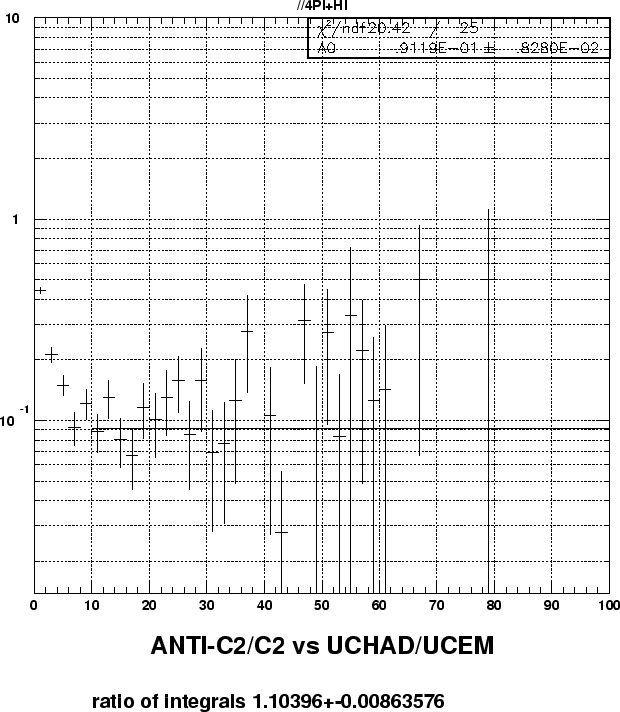



Next: Counting pions in the
Up: Pion identification
Previous: UCAL calibration
Contents
Kopytine's homepage
Correcting for the electron veto inefficiency.
The problem of electrons misidentified as pions is non-negligible in the
low field settings only, because the spectrum of electrons falls rapidly
with momentum.
The electron veto correction factor was determined using supplementary
PID provided by the UCAL electromagnetic/hadronic ratio.
The question of how tight a cut one needs to
apply in order to get the supplementary PID is of little importance,
since the electron veto inefficiency determination operates
entirely within the sample which satisfies this tough PID criterion.
This is true as long as devices used for the veto and for the supplementary
PID are uncorrelated.
The requirement of
 identifies track as a reliable hadron
and constitutes the tough, clean supplementary PID.
Fig. 4.9 shows how the ratio of tracks that exceed
the pion
identifies track as a reliable hadron
and constitutes the tough, clean supplementary PID.
Fig. 4.9 shows how the ratio of tracks that exceed
the pion  veto cut to those that do not
(let me denote this as
veto cut to those that do not
(let me denote this as
 )
changes with
)
changes with
 .
Such figures were obtained for all low field settings and different
centralities.
.
Such figures were obtained for all low field settings and different
centralities.
Figure:
 (see text of subsection 4.4.3)
as a function of
(see text of subsection 4.4.3)
as a function of
 for the weak field, high angle, positive polarity
setting.
for the weak field, high angle, positive polarity
setting.
 |
They all have the same characteristic pattern:
the ratio falls with
 , and then becomes flat after
, and then becomes flat after
 exceeds a certain threshold
exceeds a certain threshold![[*]](file:/usr/local/lib/latex2html/icons/footnote.gif) .
From this we conclude that
.
From this we conclude that
- a high signal in
 , just as a low ratio
, just as a low ratio
 , both
characterize the same group of tracks - obviously, the
, both
characterize the same group of tracks - obviously, the  ones
ones
- contribution of the
 goes down to zero when
goes down to zero when
 gets flat, and thus one chooses the safe
gets flat, and thus one chooses the safe
 cut
cut
- for true hadrons, the reasons that cause
 to fire are unrelated
to UCAL since
to fire are unrelated
to UCAL since
 is flat above 10.
is flat above 10.
Thus we have justified the electron veto correction obtained via UCAL.
It is the factor
 |
(29) |
with the counting errors in both  counts
propagating into the systematic error of the pion yields.
counts
propagating into the systematic error of the pion yields.




Next: Counting pions in the
Up: Pion identification
Previous: UCAL calibration
Contents
Mikhail Kopytine
2001-08-09

